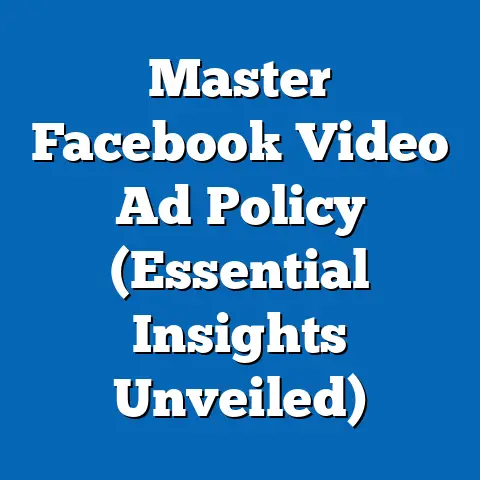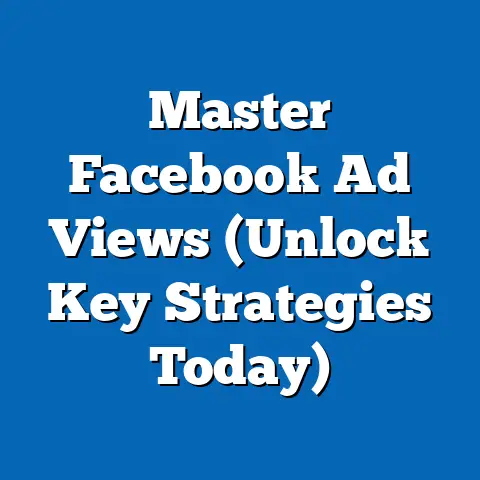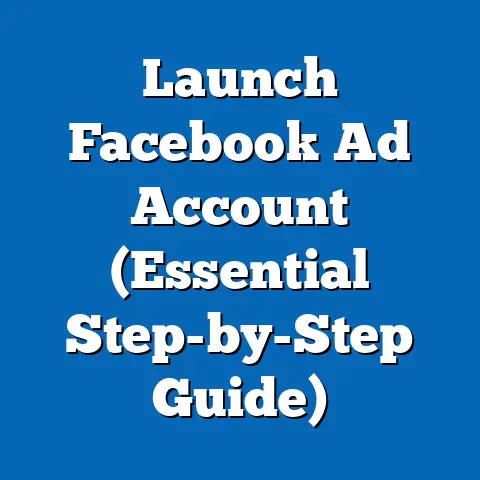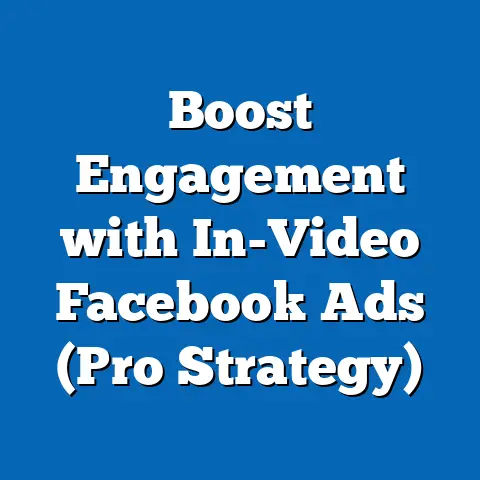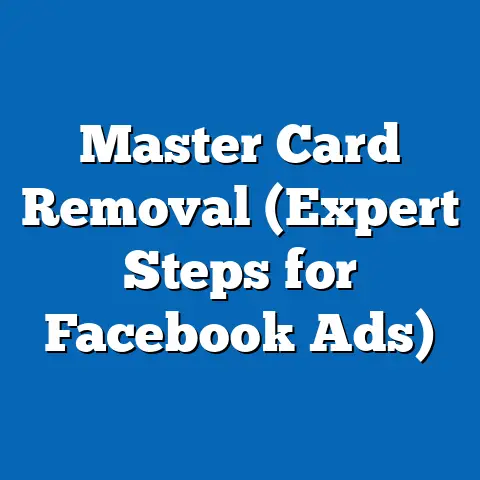Did Facebook Block My Ad? (Insights for Unshaken Courage)
Understanding Facebook’s Ad Approval Process
Facebook’s ad approval process is a complex beast, a blend of artificial intelligence and human oversight designed to maintain a safe and trustworthy environment for its users. Think of it like a bouncer at a very exclusive club – not just anyone gets in.
The Algorithm: At the heart of the process is an algorithm, a sophisticated piece of code that scans every ad submitted to Facebook. This algorithm checks for a wide range of violations, from prohibited content like hate speech or misinformation to more subtle issues like misleading claims or low-quality images.
Human Review: While the algorithm catches the majority of violations, human moderators also play a crucial role. They review ads flagged by the algorithm or those that require a more nuanced understanding of context. This human element is vital for ensuring fairness and accuracy in the approval process.
Common Reasons for Rejection: So, what gets an ad flagged in the first place? Here are some of the most common reasons:
- Prohibited Content: This includes anything that promotes illegal activities, discrimination, or violence. It also covers topics like tobacco, drugs, and weapons.
- Misleading or Deceptive Claims: Facebook takes a dim view of ads that make false or exaggerated claims about products or services. Be truthful and back up your claims with evidence.
- Poor Image Quality: Blurry, pixelated, or otherwise low-quality images can get your ad rejected. Use high-resolution images that are visually appealing and relevant to your message.
- Personal Attributes: Avoid language that directly targets users based on personal attributes like race, religion, age, or sexual orientation. This is a major no-no.
- Grammar and Punctuation: Believe it or not, poor grammar and punctuation can also lead to rejection. Make sure your ad copy is well-written and error-free.
- Destination Issues: If your ad links to a broken or irrelevant website, it’s likely to be rejected. Double-check your links!
Facebook’s Advertising Policies: The key to navigating the ad approval process is understanding Facebook’s Advertising Policies. This is the rulebook, the constitution of Facebook advertising. It’s a comprehensive document that outlines all the guidelines and restrictions that advertisers must follow. I highly recommend spending some time familiarizing yourself with these policies. You can find them easily by searching “Facebook Advertising Policies” on Google. Here are some key areas to pay attention to:
- Community Standards: These are the overarching principles that govern acceptable behavior on Facebook. Your ads must adhere to these standards.
- Prohibited Content: This section lists all the types of content that are strictly prohibited, such as hate speech, violence, and illegal activities.
- Restricted Content: This section outlines content that is allowed but subject to certain restrictions. For example, ads for alcohol or gambling may be restricted based on age or location.
- Accuracy and Relevance: This section emphasizes the importance of providing accurate and relevant information in your ads.
- Ad Creative: This section covers guidelines for ad images, videos, and text, including requirements for quality and clarity.
Takeaway: Understanding Facebook’s ad approval process is the first step toward minimizing rejections and maximizing your advertising success. Familiarize yourself with the Advertising Policies and pay close attention to the common reasons for rejection.
The Impact of Ad Rejection
Let’s be honest, getting an ad rejected on Facebook is more than just a minor inconvenience. It can have a real impact, both emotionally and financially. I’ve seen firsthand how it can derail campaigns and shake the confidence of even the most seasoned marketers.
Emotional Toll: The initial reaction to an ad rejection is often frustration. You’ve spent time crafting the perfect ad, targeting the right audience, and setting your budget. To have it all come crashing down with a single “disapproved” notification is disheartening. It can feel personal, like Facebook is unfairly targeting your business.
Financial Implications: Beyond the emotional impact, ad rejection can also have significant financial consequences. If your ad is rejected, it won’t be shown to your target audience, meaning you’re missing out on potential leads, sales, and brand awareness. This can be particularly damaging for businesses that rely heavily on Facebook advertising for their revenue.
Impact on Campaign Performance: Ad rejections can disrupt your entire campaign strategy. If you’re running multiple ads and one gets rejected, it can throw off your testing schedule and make it difficult to optimize your campaigns effectively. It also means you have to spend time troubleshooting the issue and resubmitting the ad, which can delay your progress.
Damage to Brand Reputation: In some cases, ad rejection can even damage your brand reputation. If your ads are consistently rejected for violating Facebook’s policies, it can create a negative perception of your business. People may start to associate your brand with spam, misinformation, or other undesirable content.
Stories from the Trenches: I remember working with a client who was launching a new product on Facebook. They had invested a significant amount of time and money into creating a series of ads, only to have them all rejected within the first few hours. The client was devastated, feeling like their entire launch was doomed. We had to work quickly to identify the issues, revise the ads, and resubmit them for approval. It was a stressful experience, but we ultimately managed to get the ads approved and salvaged the launch. This experience taught me the importance of being prepared for ad rejections and having a plan in place to address them.
Another example: I once ran an ad that got rejected because the image contained “excessive skin.” It was a photo of a woman wearing a swimsuit on a beach, perfectly harmless, in my opinion. But Facebook’s algorithm flagged it as potentially sexually suggestive. I appealed the decision, arguing that the image was relevant to the product I was advertising (swimwear) and didn’t violate any of Facebook’s policies. After a few days, Facebook overturned the rejection and approved the ad. This experience taught me that Facebook’s algorithm isn’t perfect and that it’s sometimes necessary to appeal their decisions.
Takeaway: Ad rejection can have a significant impact on your emotional well-being, your financial resources, and your overall marketing strategy. It’s important to be prepared for this possibility and to have a plan in place to address it quickly and effectively.
Common Misconceptions About Facebook Ad Blocks
One of the biggest challenges in dealing with Facebook ad rejections is navigating the sea of misinformation and myths that surround the process. I’ve heard it all, from claims that Facebook is biased against certain industries to conspiracy theories about random ad rejections. Let’s debunk some of the most common misconceptions:
Myth #1: Facebook is biased against certain industries.
This is a common complaint, particularly among businesses in controversial or regulated industries like cannabis, firearms, or supplements. While it’s true that Facebook has stricter policies for these industries, it’s not necessarily a sign of bias. Facebook has a responsibility to protect its users from potentially harmful or misleading content. As a result, they apply a higher level of scrutiny to ads in these industries.
Reality: Facebook’s policies are designed to protect users, not to discriminate against specific industries. If you’re in a regulated industry, make sure you’re fully compliant with all applicable laws and regulations.
Myth #2: Ads are rejected randomly.
This is another common misconception. While it may sometimes feel like ads are rejected for no reason, there’s almost always a logical explanation. The issue may be subtle or difficult to identify, but it’s usually there.
Reality: Facebook’s ad approval process is based on a set of rules and algorithms. While mistakes can happen, ads are rarely rejected randomly.
Myth #3: Appealing a rejection is a waste of time.
Some advertisers believe that appealing a rejection is pointless, arguing that Facebook never overturns its decisions. However, this is not always the case. I’ve personally had success appealing rejections in the past, particularly when I was able to provide additional information or clarify the context of the ad.
Reality: Appealing a rejection is worth a try, especially if you believe the rejection was unfair or inaccurate.
Myth #4: If an ad is rejected once, it will always be rejected.
This is simply not true. If you address the issues that led to the initial rejection, you can often get the ad approved on the second try.
Reality: Facebook’s ad approval process is iterative. If you make the necessary changes, you can often get your ad approved.
Myth #5: Facebook doesn’t care about small businesses.
This is a cynical view that I often hear from small business owners. They feel like Facebook is only interested in catering to large corporations with massive advertising budgets. However, this is not necessarily the case. Facebook recognizes that small businesses are a vital part of its ecosystem. As a result, they offer a variety of resources and support programs to help small businesses succeed on the platform.
Reality: Facebook values small businesses and provides resources to help them succeed.
Takeaway: Don’t let misconceptions and myths cloud your judgment. Understanding how Facebook’s ad approval process works is crucial for maintaining a positive mindset and navigating the challenges of advertising on the platform.
Building Resilience in the Face of Rejection
So, you’ve had an ad rejected. You’ve reviewed the policies, identified the issue, and made the necessary changes. But the sting of rejection still lingers. How do you cultivate the “unshaken courage” to keep going?
Reframe Rejection as Feedback: Instead of viewing rejection as a personal failure, try to reframe it as valuable feedback from Facebook. Each rejection provides an opportunity to learn more about the platform’s policies and how to create more effective ads.
Focus on What You Can Control: You can’t control Facebook’s algorithm or the decisions of human moderators. But you can control the quality of your ads, the accuracy of your targeting, and your overall marketing strategy. Focus on these aspects and let go of the things you can’t control.
Maintain a Positive Outlook: It’s easy to get discouraged when you’re faced with repeated rejections. But maintaining a positive outlook is essential for long-term success. Remember that every successful advertiser has faced setbacks along the way. The key is to learn from your mistakes and keep moving forward.
Find Inspiration from Others: Look for stories of successful advertisers who have overcome similar challenges. There are countless examples of businesses that have achieved remarkable results on Facebook, despite facing initial setbacks. These stories can provide inspiration and motivation to keep going.
Celebrate Small Wins: Don’t get so caught up in the big picture that you forget to celebrate small wins along the way. Every approved ad, every successful campaign, and every positive customer review is a reason to celebrate.
Remember Your “Why”: Why did you start advertising on Facebook in the first place? What are your goals and aspirations? Remind yourself of your “why” whenever you’re feeling discouraged.
Examples of Perseverance: I’ve seen countless examples of advertisers who persevered through initial setbacks and ultimately found success on Facebook. One client, a small e-commerce business selling handmade jewelry, struggled for months to get their ads approved. They kept getting rejected for violating Facebook’s policies on misleading claims and personal attributes. But they didn’t give up. They meticulously reviewed their ads, revised their copy, and adjusted their targeting. Finally, they managed to get their ads approved, and their sales skyrocketed. They went from struggling to make ends meet to generating a six-figure income in just a few months.
Takeaway: Building resilience is essential for navigating the challenges of Facebook advertising. By reframing rejection as feedback, focusing on what you can control, maintaining a positive outlook, and finding inspiration from others, you can cultivate the “unshaken courage” to keep going and achieve your goals.
Steps to Take After an Ad is Blocked
Okay, your ad has been blocked. Now what? Don’t panic! Here’s a step-by-step guide to help you navigate the situation:
Step 1: Review Facebook’s Feedback: The first thing you should do is carefully review the feedback provided by Facebook. This feedback will typically explain why your ad was rejected and what specific policies it violated. Pay close attention to this feedback, as it will be crucial for making the necessary adjustments.
Step 2: Identify the Issue: Based on Facebook’s feedback, try to identify the specific issue that led to the rejection. Was it a problem with your ad copy, your image, your targeting, or your landing page? Be as specific as possible.
Step 3: Make Necessary Adjustments: Once you’ve identified the issue, make the necessary adjustments to your ad. This may involve rewriting your ad copy, replacing your image, adjusting your targeting, or making changes to your landing page.
Step 4: Resubmit Your Ad: After you’ve made the necessary adjustments, resubmit your ad for approval. Be sure to double-check everything before you resubmit, as repeated rejections can negatively impact your account.
Step 5: Consider Appealing the Decision: If you believe that your ad was rejected unfairly or that Facebook made a mistake, you can consider appealing the decision. To appeal, simply click the “Appeal” button next to the rejected ad in your Ads Manager.
Step 6: Learn from the Rejection: Regardless of whether you appeal the decision or not, take the time to learn from the rejection. What could you have done differently to avoid the rejection in the first place? How can you improve your ads in the future?
Pro Tip: Keep a record of all your ad rejections, along with the reasons for rejection and the steps you took to address them. This will help you identify patterns and avoid making the same mistakes in the future.
Example: Let’s say your ad was rejected for violating Facebook’s policies on misleading claims. Facebook’s feedback might say something like, “Your ad makes unsubstantiated claims about the effectiveness of your product.” In this case, you would need to revise your ad copy to remove the misleading claims and provide evidence to support any claims you make. You might also consider adding a disclaimer to your ad, stating that results may vary.
Takeaway: When your ad is blocked, don’t get discouraged. Take a systematic approach to identify the issue, make the necessary adjustments, and resubmit your ad for approval. And always remember to learn from each rejection to improve your future campaigns.
Conclusion
Facebook advertising is a powerful tool, but it’s not without its challenges. Ad rejections are a common part of the process, and they can be frustrating and discouraging. But don’t let them get you down. By understanding Facebook’s ad approval process, debunking common misconceptions, building resilience, and taking the right steps after an ad is blocked, you can overcome these challenges and achieve your advertising goals.
Embrace the journey of advertising on Facebook. It’s a journey that requires creativity, innovation, and, above all, unshaken courage. Remember that rejection is not a sign of failure, but an opportunity for growth. Persist in your efforts, armed with the insights and resilience you’ve gained from your experiences. The rewards are well worth the effort.
Final Thoughts: I’ve seen firsthand the incredible results that can be achieved with Facebook advertising. But I’ve also seen the frustration and disappointment that can come with ad rejections. My goal with this guide is to provide you with the knowledge and tools you need to navigate the challenges of Facebook advertising and achieve your goals. So, go out there, create amazing ads, and don’t let a few rejections stop you from reaching your full potential. You’ve got this!


